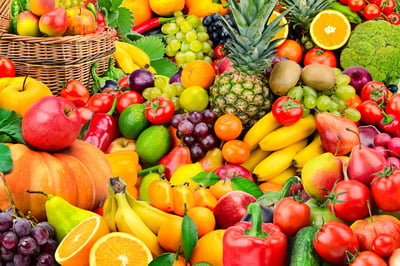Juice and smoothie flavor trends come and go, but the immense popularity of both juice and smoothies continues — and the power players won’t be juice bars, but restaurants that have all-day foot traffic, predicts John Craven, founder and CEO of BevNet. 
Maybe this will be the year your business adds a juice or smoothie program. But in the battle of juicing vs. blending, who wins? Is one healthier than the other, and is one a smarter choice for operators?
Why add fresh juice or smoothies to the menu?
The first reason can be spelled in three letters: ROI. When Florida-based franchise First Watch added the first specialty juice to its menu — a carrot, orange, lemon and ginger concoction called Day Glow — the change required a significant outlay for commercial juicing equipment. But it was a worthwhile investment, Corporate Chef Shane Schaibly told Restaurant Business: “At $3.99 for 10 ounces, Day Glow is the most expensive drink on the menu and also the most profitable—even more so than coffee—and shows no signs of cannibalizing other beverages or snack/side items, Schaibly says.”
That’s the reason juice and smoothies are so appealing for restaurant operators: They’re high-value add-ons to customers’ orders. Hotels, too, can see a meaningful ROI. After the JW Marriott Chicago opened a raw juice bar, lobby breakfast sales rose by 27 percent. It’s not only the breakfast/lunch dayparts that see a boost, either. Craft cocktail programs can benefit from having fresh juice on hand.
There’s a second reason, too: customer expectations. Millennials and Gen-Z customers have grown up with fresh juices and customized smoothies. Even as the popularity of juicing as a lifestyle (think detoxes and cleanses) wanes, expectations remain high for fresh and wholesome fruit- and vegetable-based drinks. Juice dispensed from the bar gun just won’t cut it.
Juicing vs. blending: Health benefits
While well-made juices and smoothies taste really good, their primary perceived benefit is healthfulness. Both juicing and blending are touted as quick and easy ways to consume daily recommended amounts of fruits and vegetables. The benefits aren’t equal, however.
Juicing involves extracting all the liquid from fruits and vegetables, whether by pressing or spinning the produce. Proponents of juicing say the process makes vitamins, minerals and phytonutrients instantly available to the body, although nutritionists say there’s no evidence that juice is healthier than eating the fruits and veggies themselves.
Fresh smoothies are blended in a high-performance blender from whole fruits and vegetables. This means all the natural fiber remains intact — both soluble fiber, which helps regulate blood sugar levels, and insoluble fiber, which promotes good digestion. Smoothies are also more filling than juice; they can also be good sources of protein and healthy fats with the addition of nuts, tofu or avocado.
Juicing vs. blending: Equipment
One advantage of launching a smoothie program is that equipment costs are virtually nil. If your kitchen already has a high-performance beverage blender or a culinary blender, that’s all you need. The word “high-performance” is key; you can’t rely on a cheap blender to keep up with customer demand. A durable commercial blender, on the other hand, can happily blend the day (and night) away. At Doolies Coffee and Juice Bar in Sydney, for example, one Hamilton Beach Commercial Summit blender has been making 63 drinks per day, on average, for six years. The Summit and the rest of the high-performance blender line boasts a three year warranty.
With a juice program, there’s no shortcut: You need a commercial juicer. The most basic is a citrus juicer, whether manual or electric. In an electric juicer, look for durable construction, a quiet motor and ease of cleaning. Another specialty juicer is a commercial wheatgrass juicer, which is designed specifically to extract nutrient-rich juice from wheatgrass. A powerful motor and a design that facilitates cleaning are essential.
Most juice bars, cafes, or food service operations serving a high volume of juice drinks will need a commercial juicer. These come in two varieties: a commercial centrifugal juicer with a spinning stainless steel strainer basket -- like otto™ the Juice Extractor -- and a cold press juicer, which crushes fruit and vegetables to extract the juice. The centrifugal juicer is quicker, but the cold-press process is also popular.
Juicing vs. blending: Profit
With commercial juicing, one rule of thumb is that ingredients should make up no more than 30 percent of the price of the final product. On paper, that sounds good — a $9 drink means a $6 profit — but the perishability of produce, as well as volatility of prices, make this a tough challenge. The juice itself is highly perishable, too. Unless it’s pasteurized, it’ll last no longer than 48 hours.
What about the profit margin for smoothies? One model says food costs for fresh ingredients may be as much as 50 percent; but smoothie costs can be reduced by using frozen fruit and dried ingredients. More produce is required for juicing than for blending. For example, the University of Washington calculated that two oranges, one stem of kale, half a red pepper, one cup berries, and one stalk broccoli will make about one cup of juice but about 3 cups of smoothie.
In the final analysis, you have to do your own research and decide what will work best for your operation. We've gone over several facets of these two types of programs that you might consider when looking into adding one, but keep in mind that they are not mutually exclusive.
Weighing the costs and benefits of adding a smoothie or juicing program? Talk to us! Our expert sales consultants are happy to advise clients on what they need to do, buy and plan in order to launch a successful and profitable beverage business.


